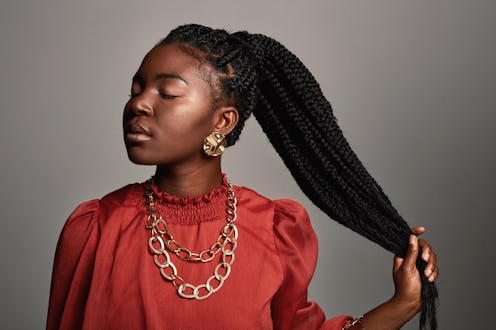Beauty
4 Expert-Approved Tips For Nailing Knotless Box Braids
A guide for knotless newbies.

If you have natural hair, chances are box braids have been a staple in your protective style rotation since childhood. Growing up, shuttling to the salon with my cousins to get fresh braids was the dawn and sweetest part of every vacation and school year. Our styles were inspired by the Black women we watched on TV during the ’90s and early aughts: Janet Jackson in Poetic Justice, Brandy in Rodgers & Hammerstein's Cinderella, Raven-Symoné in That’s So Raven, and so many more. Braids have been around for centuries, but these Black actors during cemented them as a timeless, versatile, and beautiful style for Black and Brown women.
Nearly three decades later, and braiding techniques are still evolving. In addition to tried-and-true classics like twists and cornrows, knotless box braids are a great way to give your hair and scalp a much-needed break, all while giving you a fun and fresh new look.
“Knotless box braids are individual braids with extensions that begin with creating a base with the natural hair, and the extensions are added and fed in as you go,” Stasha Harris, owner of Magic Fingers Salon and inventor of The Magic Hand, explains to Bustle. “This technique was created around 2014, but has gained momentum over the last six or seven years.” The protective style is everywhere, with celebrities like Zoë Kravitz, Jhené Aiko, Keke Palmer, and Queen Bey slaying knotless box braids on the street and red carpet.
If you’re interested in trying a new technique, Bustle spoke to braiding experts and got all the basic information you need before heading to the salon. Read on for a quick and comprehensive guide.
What Are Knotless Box Braids?
According to celebrity braider and knotless braid expert Kamilah Gerestant, knotless box braids are achieved via a “a feed-in technique of adding extension hair to a client’s natural hair.” Wondering what makes knotless braids different? “Traditional box braids are braided extensions that are added with a knot at the base to secure the synthetic hair,” she explains. “Knotless braids are exactly as the name describes and do not have the knot. The technique is not new but gained tremendous popularity in recent years.”
Because of knotless braids’ unique installation technique, the style is much easier on your scalp than other braids. “They minimize tension and pulling at the root,” Gerestant says. “Done well, knotless braids not only lay flatter to the scalp, making them more natural-looking. The weight of the braiding hair is also distributed more evenly because the pieces are “fed” into the clients natural hair piece by piece.”
How To Prep For Knotless Braid Installation
Prepping your hair and scalp prior to installing any protective style is important. Harris suggests a fresh wash and conditioning session (or deep conditioning treatment if needed), followed by detangling and blowdrying — until your strands are smooth not silky straight — to get your hair in the best shape prior to your appointment.
According to Gerestant, the ultimate goal is to start it “moisturized, clean, and healthy” natural hair. “I personally love to use Carol’s Daughter Honey Mimosa Pomade on my clients and massage throughout strands and lightly in the scalp.” If you’re in need of a trim, she also notes that if you should do that before your installation as well.
As for the type of hair you need, Gerestant says both human and synthetic work. Harris suggests using pre-stretched hair that’s 100 percent kanekalon. “My recommendation is Magic Fingers 52” Pre-Stretched Braiding Hair,” she says. “While there are other types of hair that can be used, this type provides the most seamless and time-efficient installation.”
How Long Do Knotless Braids Take?
Like any braid style, the length of your appointment depends on the size and length of the braids and the number of braiders working on your hair. “Assuming there’s an assistant, small [knotless braids] usually take five and a half hours, medium knotless braids usually take four hours, large take three hours, and jumbo box braids take two and a half hours,” Harris explains. “Expect an additional hour or hour and a half without an assistant.”
How To Refresh Knotless Box Braids
Your maintenance routine is integral to your knotless braids’ longevity. Harris suggests lightly applying vitamin E oil on the scalp once a week and gently massaging it in. At night or whenever resting, completely cover your hair with a scarf or bonnet made of silk or satin. “This will keep braids and hair at roots from frizzing too quickly,” adds Harris.
If you’re noticing flyaways and stray hairs after a few weeks, Harris recommends applying some setting mousse over the top of your braids and placing a du-rag on. Use a blow dryer for about 30-45 seconds. “This step will give braids a refreshed look,” the pro says.
Follow Harris’ steps and your braids should last six to eight weeks. Alternatively, look for braids starting to “lift from the scalp when you have about 1.5 inches of new growth.” That’ll be a cue that it’s time to take down your braids.
Make sure you keep an eye on the date or your root when wearing knotless braids. Harris says keeping in the style for too long can cause serious damage — the opposite of what you want your protective style to do.